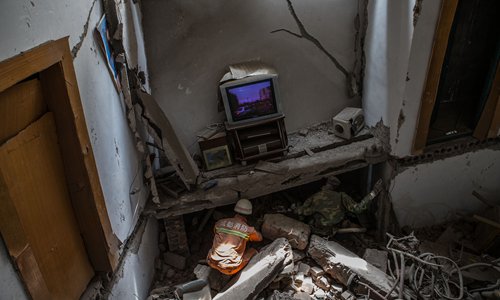
A depiction of one firemen and one soldier rescuing victims from the rubble exhibited at the Wenchuan Earthquake Museum. (Photo: Li Hao/GT)
Museum serves as poignant reminder of devastating Wenchuan earthquake
The rooms in the Wenchuan Earthquake Museum are exact replicas of those that were struck by disaster 10 years ago. The clocks on the walls are pointed to 2:28 pm, the exact time the quake hit. In one exhibition hall, piles of debris lie on the floor recreating the scene, and a television repeatedly plays a short video of the deadly shake.
On May 12, 2008, an 8.0-magnitude earthquake struck Wenchuan county, Southwest China's Sichuan Province, claiming more than 80,000 lives in the region. One month later, the museum opened. It's part of the privately-owned Jianchuan Museum Cluster in Dayi, Sichuan, founded by entrepreneur Fan Jianchuan. The museum has collected over 100,000 items related to the earthquake, including media reports, diaries, and victims' remains. Due to traffic considerations, the museum sets a limit of 2,000 visitors per day.
When the museum opened to the public on June 12, 2008, it smelled of wine. The staff didn't notice it at first, then a few visitors started chuckling. It turned out that the wine came from the shards of the jars from a local wine factory. During the earthquake, the jars broke and wine splashed everywhere.
"The museum was constructed so that people could learn a lesson and remember the disaster," Huang Yi, an employee at the communications department of the museum cluster, told the Global Times.
Salvage operation
Immediately after the earthquake hit, Fan and a few volunteers went into the disaster-struck area looking for items to collect. They brought back items that showed all aspects of the earthquake: reporters' notes, victims' remains, debris from the scene and even rescue and cleanup items, such as body bags.
"There was a small village in the mountains called Niumin, where more than 10 families were buried in a landslide," Huang said. "Their relatives found a board on the side of the road and wrote 'Rest in Peace, Our Kin,' and lit candles to commemorate them."
Later, Fan brought back the sign. He wanted people to know there was a village in the mountains where most of the people had lost their lives.
Many items at the museum tell of a similar story. There's a piece of a bloodied wedding dress that was even reported on the news. A couple were shooting their wedding photos when the earthquake struck, Huang said. The groom escaped at first, but the bride was trapped, so he went back for her. Just then, the aftershocks came and buried them in a lake.
Teaching the young
The museum has now become a popular destination for organized trips, mostly for companies and schools, and especially when the earthquake's anniversary nears. Last week, when the Global Times reporter visited, there were middle school children from Meishan, a city one and a half hours away by car.
One boy told the Global Times it was the first time he had visited the museum. His school had organized the trip because of the 10-year anniversary.
"I didn't know about any of this before. But this has been a mind-blowing experience," he said.
On May 12 every year, the museum holds a ceremony to commemorate the earthquake. People gather in the museum and stand together in silence to pay tribute to the dead.
At the end of the tour, near the museum exit, there are a few sentences printed on the wall telling of how this part of Sichuan was rebuilt.
"We deliberately used bright colors, because we wanted to show a sense of life and vitality," Huang said. "We hope people who come here can learn a lesson, but at the end also see hope rising from the debris."


















































